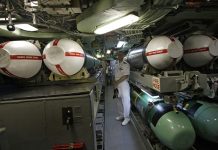The United States Navy and the Royal Canadian Navy conducted bilateral operations in the South China Sea from June 18 to June 20, showcasing a strong commitment to regional security and cooperation amid ongoing tensions between China and the Philippines.
The bilateral operations featured the US Navy’s Arleigh Burke-class guided-missile destroyer USS Ralph Johnson (DDG 114) and the Royal Canadian Navy’s Halifax-class frigate HMCS Montreal (FFH 336).
The US Navy disclosed that the activities included personnel transfers, flight operations, and replenishment at sea, supported by the Lewis-and-Clark class dry cargo ship USNS Wally Schirra (T-AKE 8).
“Close coordination with our allies and partners is paramount to success in the region,” according to Capt. Justin Harts, Commander of Destroyer Squadron 15. “Demonstrating regional cooperation with the Royal Canadian Navy is key to ensuring a free and open Indo-Pacific.”
Cmdr. Isaia Infante, commanding officer of the USS Ralph Johnson, echoed similar sentiments, emphasizing the importance of joint exercises.
“This exercise provided an opportunity to work closely with our network of allies and partners, allowing us to continue to build on the already strong relationship with the Royal Canadian Navy,” he said. “Ralph Johnson and her crew are committed to maintaining peace and stability in the Indo-Pacific region while supporting the rules-based international order.”

According to the US Navy, such bilateral engagements are crucial for training, exercising, and developing tactical interoperability across allied navies, enhancing collective readiness to address any regional contingencies.
This operation follows a recent development where Canada joined Japan and the US in a historic first joint patrol with the Philippines in the South China Sea as part of a multilateral maritime cooperation activity (MMCA) to preserve freedom of navigation and overflight.
Canada’s growing involvement in the region comes amid reports of increased aggressive maneuvers by Chinese ships, including ramming and towing, aimed at disrupting routine resupply missions to a vessel grounded by Manila on the disputed Second Thomas Shoal in the South China Sea.
The Philippines accused China of violating its sovereignty. The main issue for Manila remains the illegal presence and actions of Chinese vessels within the Philippines’ Exclusive Economic Zone (EEZ), which infringes on the nation’s sovereignty and sovereign rights.
Stagnant China-Canada Ties
The Canadian Navy’s recent joint drill with the US Navy could further strain Canada’s fragile relations with China. This development comes amidst a series of incidents over the recent years that have significantly soured Canada-China ties.
Since 2018, Canada has intermittently deployed military ships, aircraft, and personnel to conduct surveillance operations to identify suspected maritime sanctions violations, particularly ship-to-ship transfer of fuel and other commodities banned by UN Security Council resolutions.
In a notable incident reported by EurAsian Times in June 2022, Canada accused Chinese fighter pilots of engaging in dangerous interceptions of a Royal Canadian Air Force CP-140 maritime patrol aircraft since December 2021.
According to reports, Chinese jets intercepted the Canadian aircraft approximately 60 times, with nearly 20 of these encounters categorized as ‘dangerous’ due to the proximity of Chinese jets flying within 20 to 100 feet of the Canadian aircraft. The incident sparked a diplomatic dispute between the two nations.
China has consistently criticized Canada for its participation in overflights and freedom of navigation operations along with the United States, accusing Canadian military aircraft are conducting increasingly provocative reconnaissance activities under the guise of implementing UN Security Council resolutions.

China has argued that these activities were unauthorized by the UN Security Council and tantamount to spying and surveillance. China warned that such provocations increased the risk of mishaps or even conflict.
The deterioration in relations escalated in 2023 when Canada accused China of interfering in its elections, leading to reciprocal expulsions of diplomats between the two countries in May.
Canadian Prime Minister Justin Trudeau addressed the matter earlier this year. He affirmed that China had attempted to influence the outcomes of the 2019 and 2021 elections, though the efforts were unsuccessful, with his Liberal Party prevailing in both instances.
Last year, the Canadian military released documents stating that China and Russia were identified as Canada’s primary adversaries. The warnings about China closely mirrored statements made before the House of Commons Standing Committee on National Security in October 2022 and in other presentations.
The document highlighted that the absence of direct military conflict between Canada and its adversaries had sometimes delayed a robust response to hostile actions, a concern particularly relevant to the Canadian Armed Forces (CAF).
- Contact the author at ashishmichel(at)gmail.com
- Follow EurAsian Times on Google News




